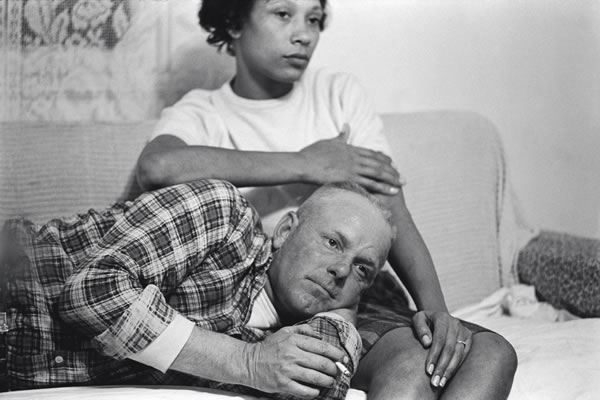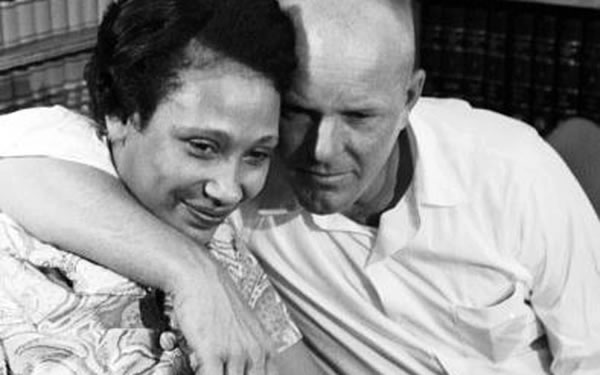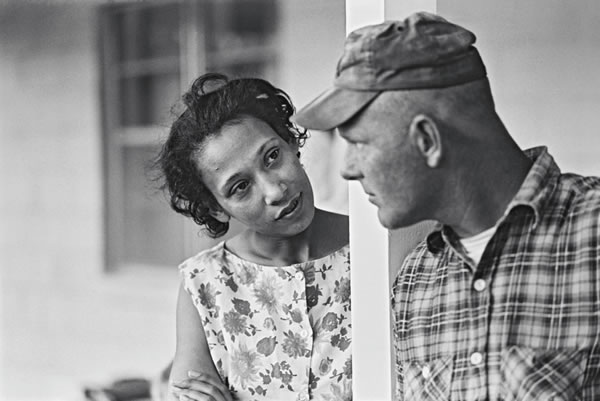
After taking the photo above, I passed the potato to the cashier and said “Decisions were made.” We had a good laugh.
Also see:

After taking the photo above, I passed the potato to the cashier and said “Decisions were made.” We had a good laugh.
Also see:

BREAKIN’ THE LAW! BREAKIN’ THE LAW! (Before 1967, anyway.)
Until June 12, 1967, sixteen U.S. states still had anti-miscegenation laws on their books. What happened on that day is now goes by a very Dickensian name: the Supreme Court decision known as Loving v. Virginia.

The “Virginia” in the case name is the same state whose original state song lyrics included the line “There’s where I labored so hard for old Massa,” and the signature line of the chorus, “There’s where this old darkey’s heart am long’d to go.”

“Loving” refers to Mildred and Richard Loving, who had been sentenced to prison for a year for the crime of marrying each other. That act was in violation of Virginia’s Racial Integrity Act of 1924, which banned marriage between people classified as “white” and those classified as “colored”. In court, they had to plead guilty to “cohabiting as man and wife, against the peace and dignity of the Commonwealth.”

On this day in 1967, the Supreme Court unanimously ruled that the Racial Integrity Act and similar laws were unconstitutional, and this ruling was also used as a precedent in Obergefell v. Hodges, the case that made same-sex marriage legal countrywide.

Today, we call June 12 Loving Day. While it’s victory for everyone, it’s especially so for me and Anitra, since it means we’re not committing a crime simply by being married.
Thank you, Mildred and Richard Loving, and Happy Loving Day, everyone!
This should be interesting: This Tuesday, June 13th at Amalie Arena, a panel comprising business, civic, and government leaders will join Tampa Bay Lightning owner and general investor-in-Tampa Jeff Vinik for an event called the 1st Annual Tampa Millennial Impact Forum. Aimed at a civic-minded audience, the panel is expect to discuss “discuss all the development going on in Tampa from a variety of perspectives including community, transportation, infrastructure, media, technology, health and wellness, legal, and government.”
If you think I’m going to be there, you’re damned right.

Moderating the event will be Roberto Torres, co-founder of the Blind Tiger Café, Cowork Ybor, and the Black and Denim Apparel Company, and who seems to have some kind of involvement with just about every interesting venture in the Tampa Bay Area, including co-sponsoring this event. I recently spent a couple of days with him at a brainstorming session at the Dali Museum, and I’m hoping to see how we can collaborate on future projects. He’s an inspiring figure, and he’s the perfect guy to cat-herd the panel of speakers who’ll be onstage.
He has this to say about the panel of speakers: “We have carefully curated a panel with an X-factor, meaning they are making an impact in other areas of civic or community engagement outside their 9 to 5 job. We hope to have a serious open conversation about the challenges of both generations — millennials and baby boomers.”

Andrew Machota co-sponsored the event. He’s the founder of New Town Connections, a social club for young professionals who want to broaden their social circle, and make connections with new people. He says that the takeaway for people who attend “should be for them to leave and actually do something proactive in the community. We all love living here, but a lot of millennials have a negative, disengaged stereotype. The goal is to be inspired by a panel of people who have stepped up and are doing phenomenal things.”

The big name on the panel is Jeff Vinik, who in addition to owning the Tampa Bay Lightning, is remaking Tampa’s Channelside area, a badly underutilized part of town in the Channel district, into a 50-acre mixed-use district with offices, hotels, shops, entertainment venues, residences, and parts of the University of South Florida. The area is being designed in consultation with a wellness company with a mandate to paying close attention to quality-of-life issues such as air quality, smart buildings with lighting systems that match circadian rhythms, bike lanes, water fountains and fruit and vegetable gardens. He’s doing this through his own investment fund, which had been joined by Bill Gates’ Cascade fund.

One interesting topic that may come up is the Tampa Bay area’s inclusion in — and subsequent removal from — Forbes’ Best Cities For Young Professionals 2017 rankings. Forbes says that a data error caused Tampa Bay and 6 other U.S. metro areas to be included in the list erroneously. It turns out that Tampa’s still in the top 100, ranking at #58.
Still, the area has lots of potential, which you can read about in another Forbes piece: Why Have So Many Millennials Become Tampreneurs?

The 1st Annual Millennial Impact Forum will take place at Amalie Arena this Tuesday, June 13, 2017. Doors open at 5:00 p.m. with the keynote by Jeff Vinik and subsequent panel discussion taking place at 6:00 p.m. Tickets are $49 in advance via EventLive.


Thanksgiving dinner must be a riot at their house.
Also worth noting: while all the books pictured were selling for a dollar apiece, Richard Dawkins’ The Selfish Gene was in a box marked “Free — take ’em all!” The marketplace of ideas at work!
(Yes, I grabbed The Selfish Gene, and also parted with a hard-earned dollar for I 

I should’ve known that Yann Weymouth, head of design for I.M. Pei’s projects at the Louvre and the National Gallery of Art in Washington and designer of the Salvador Dali Museum and the upcoming James Museum of Western and Wildlife Art in St. Petersburg, Florida, lives in the Tampa Bay area.
Oxford Exchange. Photo by Yours Truly.
 I found out only because he was the speaker at this morning’s edition of Café con Tampa, a weekly gathering where people interested in the issues that affect Tampa Bay meet to learn and share ideas in the wonderful setting of Oxford Exchange, a combination of restaurant, book store, gift shop, co-working space, design studio, event venue, and one of the best “third places” I’ve ever set foot in. Every Friday between 8 and 9 a.m., Café con Tampa features not only interesting guest speakers, but an interesting audience that’s often a mix of movers and shakers from the worlds of arts, business, academia, and government. If you want to have interesting conversations with some of the area’s movers, shakers, and idea-makers (and enjoy Oxford Exchange’s delicious breakfast spread), you should come to Café con Tampa.
I found out only because he was the speaker at this morning’s edition of Café con Tampa, a weekly gathering where people interested in the issues that affect Tampa Bay meet to learn and share ideas in the wonderful setting of Oxford Exchange, a combination of restaurant, book store, gift shop, co-working space, design studio, event venue, and one of the best “third places” I’ve ever set foot in. Every Friday between 8 and 9 a.m., Café con Tampa features not only interesting guest speakers, but an interesting audience that’s often a mix of movers and shakers from the worlds of arts, business, academia, and government. If you want to have interesting conversations with some of the area’s movers, shakers, and idea-makers (and enjoy Oxford Exchange’s delicious breakfast spread), you should come to Café con Tampa.

Weymouth opened his presentation with a Churchill quote: “We shape our buildings; thereafter, they shape us.”
He then talked about his first collaboration with legendary architect I.M. Pei: the East Wing of the National Gallery of Art in Washington, D.C.. He talked about the goals they had to achieve: being able to house a lot of art, handle large volumes of visitors, fit in the triangular zone defined by Pennsylvania Avenue, respect the existing architecture, and of course, be beautiful.

The East Wing of the National Gallery of Art.
Creative Commons photo — click here to see the source.
“Notice the glass pyramids in the design,” Weymouth said. “Do you see an evolving theme?”
After the National Gallery project, he left Pei — still remaining friends with him — to found his own architecture firm where he designed galleries and pioneering high-tech lofts.

The Louvre Pyramid.
Creative Commons photo — click here to see the source.
When I.M. Pei became the architect for the Louvre Project in the early 1980s, he invited Weymouth to be the chief designer. This was a project filled with challenges:
Also, in a conversation I had with Weymouth after his talk, there was also the issue of its being championed by then-president François Mitterand, the Fifth Republic’s first socialist leader. “A number of people left France during that time because they were concerned he’d turn the whole country communist,” he said.
The design solution he came up with was to create in the courtyard — the only space for new construction — an underground city. One-third of it is open to the public in the form of parking, a shopping mall and restaurants, with other space for art storage, operations, and roadways.
If you’re even the slightest bit worldly, you know what’s above it — the now-iconic glass pyramid. Weymouth explained the rationale behind the pyramid: “If you’re at water level by the Seine and looking at the Louvre, there’s no clear entrance. You also need some way to bring light into the underground complex.” So he designed a pyramid-shaped skylight, a classic platonic solid that would clearly mark a place to enter, and provide natural light to the subterranean expansion.
“It was controversial,” Weymoth remarked, “but so was the Eiffel Tower.”
Click the photo to see it at full size.
Why did Weymouth move to Tampa Bay? “Because of the airport,” he said, along with the brain trust of creatives that he saw accumulating in the area. It’s becoming a hub for culture, business, and technology.
In the competition to redesign the Dali Museum, the original request for proposals was for an addition to the existing building, which was a converted warehouse by the water’s edge. “I did not hew to that requirement,” Weymouth said, stating that the original building was never meant to be a museum, but a storage facility that was vulnerable to storm surges. His design, which we now know as the Dali Museum (pictured above) was a whole new building that stayed within the budget of the original proposal for an addition.
The Dali’s glass “blob” was inspired by Buckminster Fuller, whom Weymouth met in the 1960s when he was a student. He couldn’t use Fuller’s method, which was meant for geodesic spheres, for his blob design. He found a company in Milan that specialized in making free-form geodesic designs, and the result is the Dali’s blob, in which no two panes of glass are identical, and where different sizes of glass are used to accommodate different amounts of structural stress. The design was facilitated by technology that had only been around for about a decade: a combination of computer-aided design, computer-aided manufacturing, and computer-aided stress analysis.

Weymouth is currently working on the James Museum of Western and Wildlife Art, located in downtown St. Pete at the junction of Central and Beach. It’ll be larger than the Dali. “I’m taking an old office building with a parking lot on top of it, and turning it into a space that will evoke the southwest.”

 During the Q&A, a member of the audience identified himself as the nephew of British-Iraqi architect Zaha Hadid (pictured to the right), creator of some of the world’s most beautiful super-futuristic buildings — go to her Wikipedia page and look at her designs. Weymouth’s wife Susana complimented her work and pointed out to the audience that Hadid was the first woman to win the Pritzker Architecture Prize in 2004. Dame Hadid is yet another superstar architect whom I didn’t know was based in Florida (she died in Miami in 2016).
During the Q&A, a member of the audience identified himself as the nephew of British-Iraqi architect Zaha Hadid (pictured to the right), creator of some of the world’s most beautiful super-futuristic buildings — go to her Wikipedia page and look at her designs. Weymouth’s wife Susana complimented her work and pointed out to the audience that Hadid was the first woman to win the Pritzker Architecture Prize in 2004. Dame Hadid is yet another superstar architect whom I didn’t know was based in Florida (she died in Miami in 2016).
Someone asked him what his plans were when he retired. “I not going to retire,” he replied. He pointed out that I.M. Pei designed the Museum of Islamic Art in Doha, Qatar in his 90s, and that he himself was planning to continue with his work. “We become freer and more creative with experience, and at the same time, more practical.”
In response to a question about the degree to which he exceeded the budget for the Dali Museum by designing a whole new building instead of an addition, Weymouth replied that he didn’t spend more than the money allotted. “You respect the budget. You do it by prioritizing. It’s like cuisine: you boil away what’s not crucial, and you use listening and logic, covering both practical and aesthetic issues.”
When asked what he thought the two greatest innovations in construction were, Weymouth’s answers were:

I’ll close with an observation about Tampa Bay that Weymouth made (I’m paraphrasing here):
If you wanted to be at the heart of culture and interesting things happening in art around 1910, you wanted to be in Paris. Around 1920 or ’21, Berlin was the place. In the 1950s, it would be New York. And today, it’s Tampa Bay.

Yann’s not the only rock star Weymouth! His younger sister Tina was the bassist for the Talking Heads.